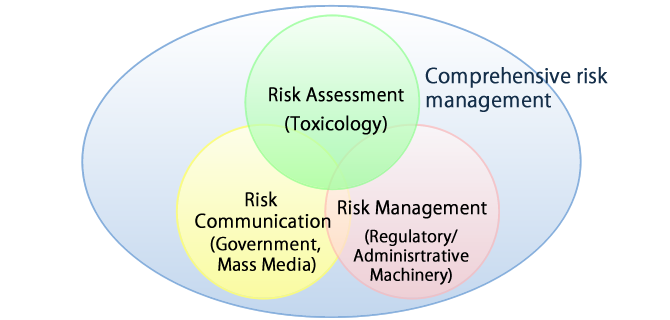A message from the Professor
A message from the Professor and his Profile
Research Principle
received training in human and experimental carcinogenesis in Nagoya City University in the Department of Pathology under the supervision of Dr. Nobuyuki Ito. After I finished my Ph.D. work, I had the opportunity to work with Prof. Emmanuel Farber at the Department of Pathology, University of Toronto and then with Prof. Peter Bannasch at the German Cancer Research Center, Heidelberg. From these and other experiences, I adopt the following principles:
Experience and Current Research
In the National Cancer Center Research Institute, I worked on cancer prevention studies, mainly bovine lactoferrin, a cow milk component having immune-enhancing activity. Based on results with animal studies, we conducted a double blind clinical study in collaboration with the National Cancer Center Hospital and found that orally administered bovine lactoferrin given to 104 patients was effective in causing regression of colorectal polyps (Cancer Prevention Research: 2, 2009). This was the first report of a cancer preventive agent effective in humans in Japan.
After I moved to the Department of Molecular Toxicology, Nagoya City University Graduate School of Medical Sciences, the first toxicology department in a medical school in Japan, I started a project evaluating the cancer risk of petroleum associated compounds, supported by the Ministry of Economy, Technology and Industry. Later, I extended this project to include the development of assay methods to determine the cancer risk of nanomaterials, such as titanium dioxide, zinc oxide, fullerens, carbon nanotubes, supported by the Ministry of Health, Labour and Welfare. We are now focusing on developing combined in vitro-in vivo assay models and mechanism analysis of toxic and carcinogenic effects of nanomaterials, concentrating on macrophage associated cytokines.
Public contribution
WHO/IARC: Working Group Member of Monograph series on the Evaluation of Carcinogenic Risks to Humans, IARC Handbook of Cancer Prevention, IARC Scientific Series, Monograph Advisory Group member, and recently Advisory Board Member for the Memorial Issue of Monograph Volume 100.
- Government:
- Expert Group Member of the pesticide subcommittee of the Food Safety Commission of the Cabinet Office, Japan (from the inauguration in 2003)
- Board
-
- Board of Pathology (Japanee Society of Pathology)
- Toxicologic Pathologist (Japanese Society of Toxicologic Pathology)
- Toxicologist (Japanese Society of Toxicology)
Academic Societies
- American Association for Cancer Research
- Japanese Society for Cancer Research
- Japanese Society of Toxicologic Pathology
- Japanese Society of Toxicology
- Japanese Association for Lactoferrin (Chairpeson of the Board of Trustees)
Main work
- Nanomaterial toxicology, focused on carcinogenesis;
- Cancer prevention and treatment by lactofrrin;
- Establishment of in vivo short-term screening model for environmental carcinogens using sensitive transgenic rats;
- Animal model of human cancer, currently pancreas cancer.
Toxicology Research in Tsuda Laboratory
According to Doll & Peto and the National Cancer Institute, smoking causes more than 30% of all cancer deaths in the U.S. and many other countries. Furthermore, the food that we eat is responsible for another 30% of cancer deaths. Other primary causes of cancer include exposure to chemical carcinogens in the workplace, diminished physical exercise (sedentary work), infection by microorganisms (viruses, Helicobacter pylori, parasites), alcohol, environmental pollutants, ionizing radiation, and medical treatment. To assure a "safe, secure and reliable" environment, three elements should work together in a balanced manner: risk assessment by academic/research institutes, risk management by the Government, and risk communication by the Government and mass media sectors. None of the 3 elements overwhelms the others. For this purpose, a Comprehensive Management Committee composed by members of research institutes, regulatory agencies, industries and consumers should be established.
Our laboratory is working on the establishment of a method to evaluate the carcinogenic effect of environmental chemicals; recently we have become more focused on engineered nanomaterials which are being rapidly introduced into the market without hazard risk evaluation.

Biography・Award
Biography
- 1975
- Ph.D. Department of Pathology, Nagoya City University Medical School, under the supervision of Prof. Nobuyuki Ito
- 1977-1979
- Postdoctoral Fellow, Department of Pathology, University of Toronto, Canada(Prof. Emmanuel Farber)
- 1983-1988
- Associate Professor Department of Pathology, Nagoya City University Medical School
- 1984
- Department of Cellular Pathology, German Cancer Research Center (Prof. Peter Bannasch)
- 1989-1993
- Associate Professor Department of Pathology, School of Medicine, Fujita Health University
- 1993-2003
- Chief, Experimental Pathology and Chemotherapy Division, National Cancer Center Research Institute, Japan
- 2003-2008
- Professor, Department of Molecular Toxicology, Nagoya City University Graduate School of Medical Sciences
- 2009−
- Professor, Nanomaterial Toxicology Project, Nagoya City University
Award
- 1997
- Tamiya Memorial Award
(Japanese Foundation for Promotion of Cancer Research) - 2009
- Minister Award (Minister of Health Labour and Welfare)
- 2010
- Princess Takamatsu Cancer Research Fund Prize
(Kras transgenic rat pancreas ductal cancer model)



